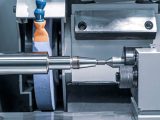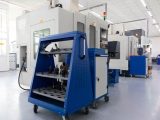
Safety First: Using Oscilloscope Current Probes with High Voltage Circuits
October 8, 2025Working with high voltage circuits is no place for guesswork. One wrong move can lead to sparks, shocks, or damaged equipment. An oscilloscope makes it possible to see what is happening in real time, but measuring current requires more than the scope alone. This is where an oscilloscope current probe comes in, giving you a safer and clearer way to track current without sticking your neck or hands where they should not be.
How an Oscilloscope Current Probe Works
An oscilloscope is designed to measure voltage. To look at current, you need a tool that translates current into a signal the oscilloscope can display. That role falls to the oscilloscope current probe. It clips around a conductor, often without direct electrical contact, and converts the magnetic field into a voltage. The scope then plots this voltage as a waveform, showing how the current changes over time.
The benefit of this method is clear. Instead of breaking into a circuit to add a resistor or sensor, you clamp the probe around the wire. The reading comes through without cutting, splicing, or risking exposure to high voltage. It is a safer method and keeps the circuit intact.
Safety Advantages
The oscilloscope current probe acts like a shield. Avoiding direct contact with live parts reduces the chance of electric shock. Probes are often insulated to handle high-voltage environments, offering both protection and accuracy. Some models come with a specified voltage limit, ensuring they are safe for industrial and laboratory use. Always checking the ratings before connecting is key, as not every probe is built for the same level of stress.
When handling high voltage, the smallest mistake can be costly. A poor ground connection or an underrated probe can put both the user and the oscilloscope at risk. Following manufacturer guidelines, wearing proper gear, and double-checking connections are steps that make measurement both reliable and safe.
Applications in High Voltage Testing
In power electronics, oscilloscopes paired with current probes are essential. They allow engineers to observe switching behaviour in inverters and converters. For instance, checking the performance of an inverter in a solar system requires accurate current and voltage waveforms. The oscilloscope, combined with a current probe, shows whether the system is running smoothly or wasting power.
Automotive testing also benefits. Electric and hybrid vehicles rely on high-voltage systems, from battery packs to drive units. Measuring current flow safely is critical to both performance and safety testing. With a probe in place, the oscilloscope provides a clear picture of how components behave under load, without exposing technicians to dangerous contact.
In industrial maintenance, oscilloscope current probes help keep motors and control systems in check. Engineers can see how the current responds during start-up or heavy loads, spotting faults before they cause downtime.
Practical Tips for Safer Use
One key point is calibration. A probe that is not calibrated can give misleading results. Most modern probes allow for easy zeroing to ensure accurate measurements. Another tip is to use the right bandwidth. A probe rated too low may miss fast changes in current, while one rated appropriately will capture the full signal.
Positioning also matters. Placing the probe correctly around a single conductor ensures accurate readings. If you accidentally clamp around both the live and return conductors, the currents cancel, and the scope shows nothing useful. Knowing where to clip is as important as having the right probe.
Lastly, storage and care extend a probe’s life. High-voltage testing environments are harsh, and probes are precision instruments. Storing them properly, avoiding physical stress, and regular checks ensure they remain dependable.
Trends in Safe Measurement
Engineers continue to look for safer ways to measure current. Portable probes now allow technicians to bring light tools into tight areas such as engine rooms or factory floors. Another approach is to use probes with cloud-based logging, which lets teams monitor high voltage behaviour remotely and share records when needed. These practices balance safety with accuracy and make testing more practical.
Why Engineers Use Them
An oscilloscope current probe helps maintain both safety and measurement accuracy in high-voltage circuits. This combination allows for controlled testing and dependable results. In renewable energy systems, electric vehicles, and industrial machinery, engineers rely on these probes to monitor performance without unnecessary exposure.
Rather than framing current as a metaphor, the point is clear: using the right probe provides a complete picture of circuit behaviour while keeping risk low.
Choosing the Right Setup
The oscilloscope current probe makes working with high-voltage circuits manageable, clear, and safe. By keeping measurements indirect and precise, it protects both the user and the equipment. From energy systems to automotive workshops, it proves its value every day.
If you work with high voltage, do not let safety take a back seat. Contact Genetron to find the right probe and oscilloscope setup for your testing needs.








